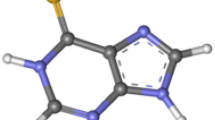Abstract
The present study deals with the electronic structure of the bioactive anticancer drugs based on platinum(II) complexes: cisplatin PtCl2(NH3)2, carboplatin PtC6H12N2O4 and oxaliplatin PtC8H14N2O4, which are being used in cancer treatment. The purpose of the work was to examine the molecular and electronic structure of platinum(II) coordination complexes when they undergo hydrolysis, which is crucial in order to better understand their antitumor properties. The density functional theory (DFT) was used to investigate the electronic structure of the platinum(II) complexes under study. The process of hydrolysis was simulated, and the structure and geometry of hydrolyzed platinum complexes were determined. The electronic structure, energy levels of occupied and unoccupied MOs and the distribution of the total and partial electron density of states (DOS) were shown and the UV-Vis and oscillation spectra of the hydrolyzed platinum(II) complexes were calculated. The theoretical calculations were verified by the experimentally obtained data by applying the method of X-ray absorption at PtL 3 edge as well as UV-Vis and IR spectroscopic techniques.
Similar content being viewed by others
References
D. Esteban-Fernandez, E. Moreno-Gordaliza, B. Canas, M. A. Palacios, and M. M. Gomez-Gomez, Metallomics, 2, 19–38 (2010).
N. J. Wheate, S. Walker, G. E. Craig, and R. Oun, Dalton Trans., 39, No. 35, 8097–8340 (2010).
G. te Velde, F. M. Bickelhaupt, S. J. A. van Gisbergen, C. Fonseca Guerra, E. J. Baerends, J. G. Snijders, and T. Ziegler, J. Comput. Chem., 22, 931–967 (2001).
ADF2009.01, SCM, Theoretical Chemistry, Vrije Universiteit, Amsterdam, Netherlands; http://www.scm.com.
S. H. Vosko, L. Wilk, and M. Nusair, Can. J. Phys., 58, 1200–1211 (1980).
J. J. Rehr, J. J. Kas, M. P. Prange, A. P. Sorini, Y. Takimoto, and F. Vila, C. R. Phys., 10, 548–559 (2009).
J. J. Rehr, Radiat. Phys. Chem., 75, 1547–1558 (2006).
A. L. Ankudinov, B. Ravel, J. J. Rehr, and S. Conradson, Phys. Rev. B, 58, No. 12, 7565–7576 (1998).
J. J. Rehr and A. L. Ankudinov, Radiat. Phys. Chem., 70, 453–463 (2004).
Y. Joly, Phys. Rev. B, 63, 125120–125129 (2001).
Y. Joly, Phys. Rev. Lett., 68, 950–953 (1992).
P. Blaha, K. Schwarz, et al., Wien2k (2008).
Author information
Authors and Affiliations
Corresponding author
Additional information
Translated from Zhurnal Strukturnoi Khimii, Vol. 57, No. 7, pp. 1558-1565, September-October, 2016.
Rights and permissions
About this article
Cite this article
Polozhentsev, O.E., Kochkina, V.K., Mazalova, V.L. et al. Molecular and electronic structure of hydrolized platinum anticancer drugs as revealed by X-ray absorption, IR, UV-Vis spectroscopies and DFT calculations. J Struct Chem 57, 1477–1484 (2016). https://doi.org/10.1134/S0022476616070246
Received:
Published:
Issue Date:
DOI: https://doi.org/10.1134/S0022476616070246




